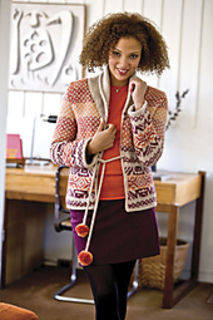patterns > Interweave Books / eBooks >  Color Style: Innovative to Traditional, 17 Inspired Designs to Knit
Color Style: Innovative to Traditional, 17 Inspired Designs to Knit
> Cunningsburgh Star Jacket


Cunningsburgh Star Jacket
Pattern Description from Color Style: “A simple four-stitch, four-row Fair Isle pattern decorates much of Shirley Paden’s warm shawl-collar jacket. She worked the background stitches in off-white throughout, but changed the color of the pattern stitches in wide bands. She added a large star motif, which shades from dark to light to dark again, as a focal point along the lower body and sleeves. The jacket fastens with an I-cord belt threaded through eyelets at the waist. Colorful pom-poms finish off the ends of the belt and prevent it from inadvertently slipping out of the eyelets. To maintain the clean lines of the silhouette, Shirley trimmed the edges with I-cord.”
Finished Size: 35 (46½)“ (89 118 cm) bust circumference, fastened. To fit bust sizes 31-34 (36-44)” (79-87 92-112 cm). Note: Due to the large number of stitches in the star motif, only two sizes are provided.
Yarn: Worsted weight (#4 Medium)
Classic Elite Montera (50% llama, 50% wool; 127 yd 116 m/100 g): #3845 fieldstone heather (ecru; MC), 7 (9) skeins; #3833 honeybell (orange), #3885 bolsita orange (burnt orange), #3868 ancient orange (rust), and #3827 cochineal (plum), 1 skein each.
Needles: Body and sleeves - size U.S. 10 (6 mm). Collar and I-cord - size U.S. 9 (5.5 mm): straight and set of 2 double-pointed (dpn). Edging - size U.S. 8 (5 mm): 32” (80 cm) cir. Adjust needle size if necessary to obtain the correct gauge.
Notions: Marker (m); tapestry needle; waste yarn; stitch holders; three white hook-and-eye closures (available at fabric stores); sharp-point sewing needle and matching thread.
Notes:
- “A garter-stitch selvedge is worked at each selvedge edge. Work all increases and decreases inside these selvedge stitches.”
- “The number of rows to be worked is provided for each color change so that the flow of color from bottom to top is consistent.”
1628 projects
stashed
2035 times
- First published: September 2008
- Page created: October 21, 2008
- Last updated: October 14, 2020 …
- visits in the last 24 hours
- visitors right now




